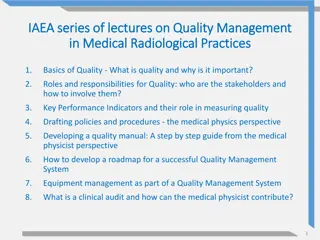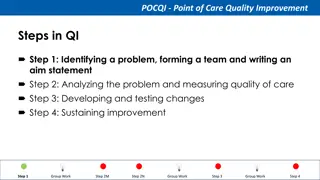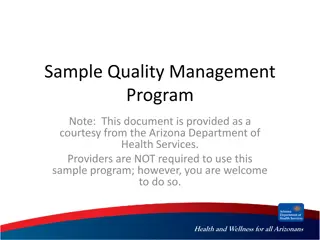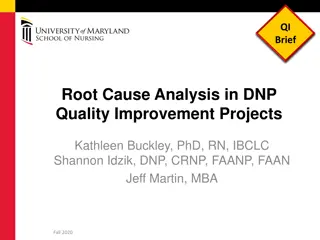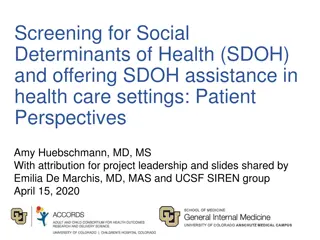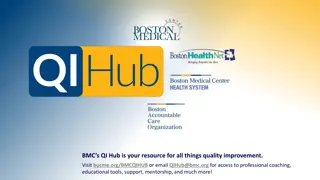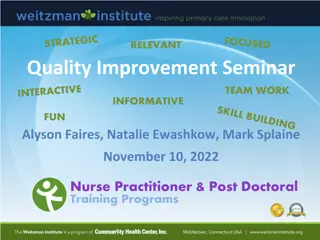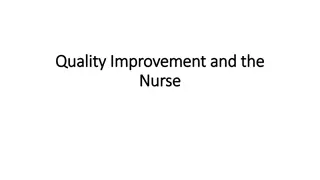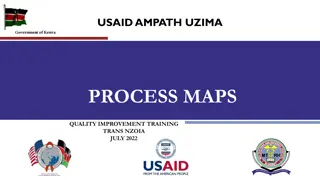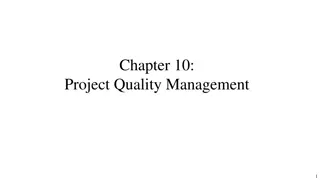Establishing Quality Improvement Structures in Healthcare Settings
Learn about the importance of Quality Improvement Teams (QITs) and Work Improvement Teams (WITs) in healthcare facilities, their formation processes, roles, and responsibilities. Discover how QITs and WITs contribute to enhancing decision-making, commitment to quality improvement, and overall healthcare service delivery.
Download Presentation

Please find below an Image/Link to download the presentation.
The content on the website is provided AS IS for your information and personal use only. It may not be sold, licensed, or shared on other websites without obtaining consent from the author. Download presentation by click this link. If you encounter any issues during the download, it is possible that the publisher has removed the file from their server.
E N D
Presentation Transcript
USAID AMPATH UZIMA ESTABLISHING QI STRUCTURES QUALITY IMPROVEMENT TRAINING TRANS NZOIA JULY 2022
LEARNING OBJECTIVES By the end of this session, participants will be able to: Describe establishing a QI structure Define roles and responsibilities of members of a QI Team Identify good candidates for QI Team members and leaders Describing stages of team formation Attitude and QI success Describing roles and responsibilities of QITs & WITs USAID AMPATH Uzima
ESTABLISHING A QI STRUCTURES Quality Improvement Team (QITs) The Quality Improvement Teams should aim at improving the speed of decision-making and enhance commitment for quality improvement in the hospital/health facility How is QIT Formed: Nominated by the top leadership and should include members of the Health Facility Management Team and Middle Management 9/23/2024 3 USAID AMPATH Uzima
ESTABLISHING QI STRUCTURES Quality Management Infrastructure - QMT Sub-county/County . Core facility-based structures in KQMH: I. Quality Improvement Team (QIT) II. Work Improvement Team (WIT) USAID AMPATH Uzima
Roles (ToR) of the Quality Improvement Team: Main roles: Coordinate planning and implementation of quality improvement activities Sets overall vision for QI in facility Mentorship and coaching to WIT Promotes WITs activities Selects and appoints WITs facilitators Evaluates and rewards WITs activities Allocates resources for WITs operation Facilitates Total Quality Management 9/23/2024 5 USAID AMPATH Uzima
Work Improvement Teams (WITs) Essentially employee-based (workers/implementors)teams. How is WIT Formed? Nominated by QIT and departmental management Should be 3-15 members of same work unit who meet regularly to identify, analyze and solve problems and improve outputs of their work unit. USAID AMPATH Uzima
Primary Roles of WITs: Implement CQI activities at section level (5-S, PDSA) and ongoing performance measurement Share and disseminate findings Work with QIT to institutionalize changes USAID AMPATH Uzima
What are WITS Objectives? WITS aim to improve: Performance - Quality of service, output - Productiveness Motivation - Making work more meaningful - Providing little challenges here and there - Having open and effective communication - Developing more positive attitudes The Quality of work life - Job satisfaction - Work environment - Teamwork and human relations 9/23/2024 8 USAID AMPATH Uzima
Composition of Q(W)ITs 1. 2. Team Leader- 3. Sponsor/Initiator - Someone who suggests new ideas. One or more people can have this role at a time. 4. Rapporteur/Secretary Documentation of minutes .. 5. Devil's Advocate/Skeptic - This is someone whose responsibility is to look for potential flaws in an idea. 6. Optimist - Timekeeper - Someone who tracks time spent on each portion of the meeting. 7. Subject matter experts.. 8. Members .. Patron: someone with clout 9/23/2024 USAID AMPATH Uzima
QITEAM RESPONSIBILITIES: SPONSOR/INITIATOR Charters the improvement teams Provides the initial improvement goal and monitors the team progress. Develops the initial QI charter, before teams refine it further. Supports the QI teams through the implementation process This role can be a group of people or a person e.g. the ScHMT can be the sponsor of a QI initiative. USAID AMPATH Uzima
QI TEAMRESPONSIBILITIES: LEADER Organizes and directs the work of the QI Team Develops meeting agendas and timelines, recruits members and monitors progress Identifies need for other technical and QI support Acts as the link between service delivery and facility management Provides management updates Bears responsibility for implementing change USAID AMPATH Uzima
QI TEAM RESPONSIBILITIES: QI EXPERT Establishes a contract with the QI Team Leader to define how to intervene, whether through the Leader or directly with the QI Team Guides QI Leadership Team through the QI process Improvement steps QI Tools Analyses Monitors QI Team effectiveness and suggests ways to enhance performance USAID AMPATH Uzima
QI TEAM RESPONSIBILITIES: MEMBERS Present reality in analysis of the current situation Represent the concerns of the provider/supplier/customer/beneficiary group, as appropriate Carry out assignments between meetings USAID AMPATH Uzima
QI TEAM RESPONSIBILITIES: RAPPORTEUR Records and maintains QI Team documents Meeting notes (agendas, minutes, attendees) Results of analyses Team storyboard Provides communication among QI Team members, QI Team Leadership and external people Ensures ideas are captured and displayed during discussion newsprint Prepares publications and information releases USAID AMPATH Uzima
QUALITY IMPROVEMENT TEAMS (QITs) & WORK IMPROVEMENT TEAMS (WITs) FOR PRODUCTIVITY AND QUALITY IMPROVEMENT USAID AMPATH Uzima
Definitions A Team is a group of people working together to achieve a common goal for which they share responsibility Team work is solving problems together whereby all members have the ability to influence decisions and apply their strengths effectively USAID AMPATH Uzima
Team work is not A group of people and one STAR who does all of the work. Neither is it A group of people and a leader dictating to them what to do. USAID AMPATH Uzima
TEAM DYNAMICS Stages of team development; Forming; inclusion and acceptance Storming; Assert control fight for own voice Norming; Teams have clarity on the goal and objectives, want to accomplish goal. Performing; Highly effective problem solving stage Closing; All teams go through this process but not necessarily in the order above USAID AMPATH Uzima
Stages of team development Forming Storming Norming Performing Closing USAID AMPATH Uzima
Stage 1 - Forming When a team is forming: Members cautiously explore acceptable group behavior People s roles change from individual to member Members may challenge the authority of the leader/coach BUT also tend to depend on them for orientation and direction This stage is complete when members begin to think of themselves as part of the team. USAID AMPATH Uzima
Stage 2 - Storming Storming is critical to effective group development Tasks ahead may seem harder than expected Some team members may become impatient, argumentative and resist collaborating with each other This stage provides the opportunity for individuals to establish their own expertise within the group They will forge ways of working together and respect each other s point of view This stage is complete when there is a relatively clear hierarchy of leadership within the group USAID AMPATH Uzima
Stage 3 - Norming During this stage members realize their: Common goals Begin to accept the team Roles and the individuality of fellow members As a result conflicts are minimal and there is more cooperation This stage is complete when the group structure becomes established and the team develops a shared understanding of how a team member should behave. USAID AMPATH Uzima
Stage 4 - Performing During this stage: - The team starts identifying, solving problems, choosing and implementing changes - Members accept each other s strengths, weaknesses, and know their own roles It is during this stage that the team performs at its best. USAID AMPATH Uzima
Stage 5 - Closing The work of a problem-solving or quality improvement team is intended to end when process improvements are in place The team must deal with either the success or failure of their efforts and the dissolution of the team The team should identify lessons learned and plan how they will be communicated The leader and team celebrate their successes and provide support if the project has not been successful USAID AMPATH Uzima
Success of KQMH-5S-CQI (KAIZEN) implementation depends on: Leadership Commitment Positive mindset & Everyone s participation USAID AMPATH Uzima
Attitude is a little thing that makes a big difference. ~Winston Churchill USAID AMPATH Uzima
The greatest discovery of my generation is that human beings can alter their lives by altering their attitudes of mind . William James of Harvard University USAID AMPATH Uzima
Attitude Everyone likes to do what he or she likes and not what should be done Why? 28 USAID AMPATH Uzima
Answer is. Knowledge and Skills aren t enough. It s your positive attitude which makes the difference . 29 USAID AMPATH Uzima
So, lets ask ourselves these important questions Can an executive be a good executive without a good attitude? Can a student be a good student without a good attitude? Can parents, teachers, employers or employees be good in their roles without a good attitude? Yatafakari Hayo!! USAID AMPATH Uzima
What is attitude? On the surface, attitude is the way you communicate your mood to others. When you are optimistic and anticipate successful encounters, you transmit a positive attitude and people usually respond favorably. When you are pessimistic and expect the worst, your attitude is often negative and people tend to avoid you. Inside your head, where it all starts, attitude is a mind-set. It is the way you look at things mentally. Negative thinking can become a destructive habit. Watch your thoughts more closely, and aim to turn your negative self-attitude around. 31 USAID AMPATH Uzima
WHAT MAKES YOUR LIFE 100% ? Let each letter of the alphabet has a value equals to it in the sequence of the alphabetical order: A B C D E F G H I 1 2 3 4 5 6 7 8 9 10 11 12 13 14 15 16 17 18 19 20 21 22 23 24 25 26 S K I L L S 19 11 9 12 12 19 = J K L M N O P Q R S T U V W X Y Z 82 K N O W L E D G E 1114152312 5 4 7 5 96 = H A R D 8 1 12 4 W O R K 23151811 98 = A T T 1 20 20 9 20 21 4 5 I T U D E = 100 32 USAID AMPATH Uzima
THE ICEBERG THE ICEBERG EFFECT HOW MUCH DO YOU SEE OF AN ICEBERG? 33 USAID AMPATH Uzima
Key points This session focused on: Defining team and team work Describing stages of team formation Attitude and QI success Describing roles and responsibilities of QITs & WITs USAID AMPATH Uzima
USAID AMPATH UZIMA THANK YOU info@ampathkenya.org | www.ampathkenya.org | @ampathkenya




